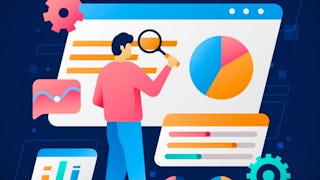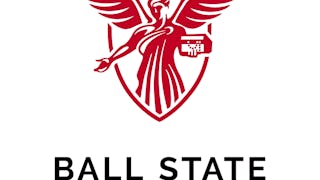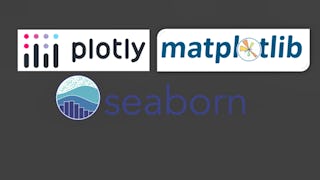This course introduces the core principles of data visualization and how to use them to craft compelling narratives. Over eight modules, students will learn how to visualize data effectively, select appropriate charts, and integrate advanced techniques such as interactivity, geospatial mapping, and storytelling. By the end of the course, students will have created a portfolio of visualizations that communicate data-driven stories.



Expérience recommandée
Ce que vous apprendrez
Understand the core principles of data visualization.
Use visual storytelling to communicate data insights.
Compétences que vous acquerrez
- Catégorie : Geospatial Mapping
- Catégorie : Storytelling
- Catégorie : Data Ethics
- Catégorie : Box Plots
- Catégorie : Data Storytelling
- Catégorie : Histogram
- Catégorie : Scatter Plots
- Catégorie : Data Presentation
- Catégorie : Data Visualization Software
- Catégorie : Design Elements And Principles
- Catégorie : Interactive Data Visualization
- Catégorie : Infographics
Détails à connaître

Ajouter à votre profil LinkedIn
octobre 2025
33 devoirs
Découvrez comment les employés des entreprises prestigieuses maîtrisent des compétences recherchées

Il y a 9 modules dans ce cours
This module introduces the core principles and significance of data visualization. Learners will explore the history and development of data visualization, understand how visual perception plays a role in interpreting data, and gain experience creating basic charts like bar charts, line charts, and pie charts.
Inclus
21 vidéos7 lectures4 devoirs1 sujet de discussion
In this module, we will explore the foundational concepts of data types and their importance in analysis and visualization. By understanding the differences between qualitative and quantitative data and the four levels of measurement (nominal, ordinal, interval, and ratio), you'll gain the skills to select appropriate visualizations that accurately represent your data. This knowledge forms the basis for creating impactful and meaningful data stories.
Inclus
13 vidéos5 lectures4 devoirs1 sujet de discussion
This module focuses on visualizing relationships, distributions, and patterns within datasets. You will learn how to use tools like scatter plots, histograms, and box plots to uncover trends, correlations, and outliers, as well as compare datasets effectively. These skills are essential for interpreting data and communicating insights with clarity and precision.
Inclus
13 vidéos6 lectures4 devoirs
In this module, students will explore the art of crafting compelling data-driven narratives. By combining design principles with storytelling techniques, they will learn how to structure data stories that engage and inform their audience. Key topics include the role of storytelling in visualization, creating visual hierarchies to guide viewers, and designing narratives using tools like data dashboards. This module emphasizes the importance of connecting data insights to meaningful messages.
Inclus
13 vidéos5 lectures4 devoirs
Explore advanced techniques for creating more dynamic and interactive visualizations to engage audiences and convey complex insights.
Inclus
14 vidéos5 lectures4 devoirs
In this module, students will learn how to visualize geographical data using maps and geospatial tools to uncover insights and tell compelling location-based stories.
Inclus
13 vidéos6 lectures4 devoirs
This module emphasizes the importance of accessibility and ethical practices in data visualization. Students will learn how to create inclusive visualizations that accommodate diverse audiences and avoid misleading representations. Through practical lessons on accessible design, color schemes, and transparency, students will gain the tools to communicate data responsibly and effectively.
Inclus
13 vidéos6 lectures4 devoirs
This final module brings together all the concepts explored throughout the course. Students will apply their knowledge by developing a comprehensive data story that combines multiple visualization techniques. Through this project, learners will demonstrate their ability to structure narratives and communicate insights effectively for a specific audience using real-world data.
Inclus
13 vidéos4 lectures4 devoirs
This module contains the summative course assessment that has been designed to evaluate your understanding of the course material and assess your ability to apply the knowledge you have acquired throughout the course.
Inclus
1 devoir
Instructeur

Offert par
En savoir plus sur Data Analysis
 Statut : Essai gratuit
Statut : Essai gratuitFractal Analytics
 Statut : Essai gratuit
Statut : Essai gratuitJohns Hopkins University
 Statut : Prévisualisation
Statut : PrévisualisationBall State University

Coursera Project Network
Pour quelles raisons les étudiants sur Coursera nous choisissent-ils pour leur carrière ?





Ouvrez de nouvelles portes avec Coursera Plus
Accès illimité à 10,000+ cours de niveau international, projets pratiques et programmes de certification prêts à l'emploi - tous inclus dans votre abonnement.
Faites progresser votre carrière avec un diplôme en ligne
Obtenez un diplôme auprès d’universités de renommée mondiale - 100 % en ligne
Rejoignez plus de 3 400 entreprises mondiales qui ont choisi Coursera pour les affaires
Améliorez les compétences de vos employés pour exceller dans l’économie numérique
Foire Aux Questions
To access the course materials, assignments and to earn a Certificate, you will need to purchase the Certificate experience when you enroll in a course. You can try a Free Trial instead, or apply for Financial Aid. The course may offer 'Full Course, No Certificate' instead. This option lets you see all course materials, submit required assessments, and get a final grade. This also means that you will not be able to purchase a Certificate experience.
When you purchase a Certificate you get access to all course materials, including graded assignments. Upon completing the course, your electronic Certificate will be added to your Accomplishments page - from there, you can print your Certificate or add it to your LinkedIn profile.
Yes. In select learning programs, you can apply for financial aid or a scholarship if you can’t afford the enrollment fee. If fin aid or scholarship is available for your learning program selection, you’ll find a link to apply on the description page.
Plus de questions
Aide financière disponible,


